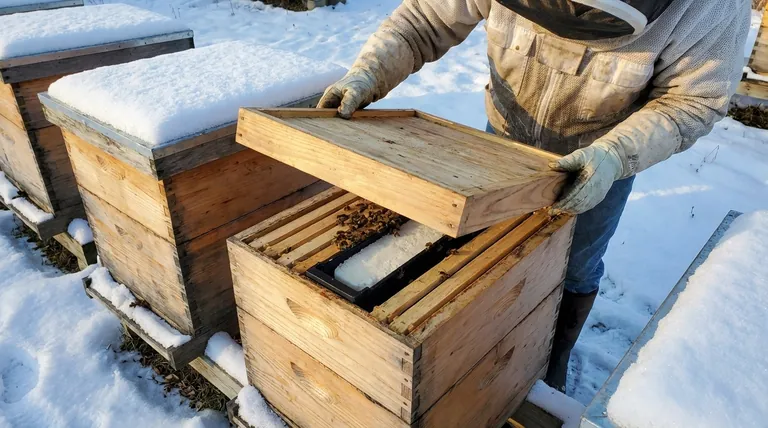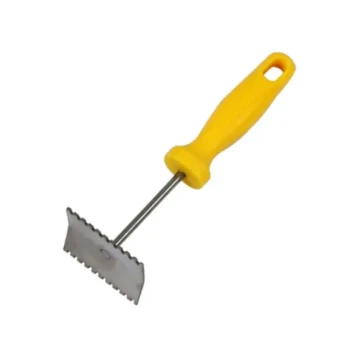In short, winter patties are a form of emergency insurance for your bee colony. They are a supplemental feed, composed primarily of sugar, placed directly inside the hive during the coldest months. Their sole purpose is to provide a readily available source of carbohydrates, which the bees convert into the energy needed to generate heat and survive when their natural honey stores run low.
The central takeaway is that winter feeding strategy hinges on a critical distinction: winter patties provide carbohydrate energy for survival, while pollen patties provide protein that stimulates brood rearing. Using the wrong one at the wrong time can endanger the colony.

The Role of Winter Feeding: Energy for Survival
A common misconception is that bees hibernate. In reality, they form a tight "winter cluster" and work continuously to stay warm, consuming significant energy stores to survive until spring.
Why Bees Need Winter Energy
The winter cluster is a marvel of biological engineering. Bees in the center care for the queen, while bees on the outer layer shiver their wing muscles to generate heat, maintaining a core temperature that ensures survival.
This constant activity requires a massive amount of fuel. That fuel comes from carbohydrates, which they ideally get from the honey they stored during the previous season.
The Ideal Food: Stored Honey
A beekeeper's primary goal should be to ensure the colony has enough of its own honey to last the winter. Honey is the perfect food, containing the exact blend of sugars and trace elements bees need.
Supplemental feeding, therefore, is not the first plan; it is a backup plan. It becomes necessary only when the colony's own pantry is running empty.
When Supplemental Feeding Becomes Necessary
You should consider providing winter patties if you observe signs that the colony is light on stores. This can be determined by lifting the back of the hive (hefting) in the fall or during a brief warm spell in winter.
If the hive feels surprisingly light, it's a clear signal that the bees are at risk of starvation and need an emergency energy source.
Winter Patties vs. Pollen Patties: A Critical Distinction
While both are "patties," their composition and purpose are fundamentally different. Understanding this difference is crucial for successful wintering.
Winter Patties: Pure Carbohydrates for Heat
Winter patties are almost entirely sugar (carbohydrates). They are designed to be an energy-dense food that is easy for the bees to access, even within the tight confines of the winter cluster.
Their function is singular: to provide fuel for heat generation. They do not stimulate the colony to grow.
Pollen Patties: Protein for Brood Rearing
Pollen patties, by contrast, contain pollen or a protein-rich pollen substitute. Protein is the key nutritional signal that tells a colony it is time to raise young.
When nurse bees consume protein, they begin producing royal jelly, which prompts the queen to start laying eggs. This is desirable in late winter or early spring to build the workforce for the first nectar flow, but not in deep winter.
The Danger of Early Brood Rearing
Feeding a pollen patty too early is a common and serious mistake. It tricks the queen into laying eggs when the colony should be conserving all its energy for warmth.
Raising brood requires the cluster to maintain a much higher temperature (around 35°C / 95°F) and consume even more food. If a cold snap occurs, the smaller winter cluster may be unable to keep both itself and the new brood warm, leading to chilled brood and potentially the death of the entire colony.
Understanding the Trade-offs and Risks
While supplemental feeding can be a lifesaver, it's important to be aware of the potential downsides.
Risk of Increased Moisture
Sugar patties can absorb ambient moisture inside the hive. If condensation becomes excessive, it can drip down onto the bees, chilling them. Proper upper ventilation is essential to allow this moist air to escape.
Feeding Can Mask Other Problems
Routinely feeding a colony can become a crutch that masks underlying issues, such as a weak queen, disease, or poor foraging performance. The primary goal should always be to manage strong, healthy colonies that can provide for themselves.
Attracting Pests
Any food source can be an attractant for pests. While patties inside the hive are relatively safe, beekeepers must ensure the hive is secure from rodents and other pests that may be drawn to the smell.
How to Choose the Right Feeding Strategy
Your feeding decision should be based entirely on your specific goal for the colony at a specific time of year.
- If your primary focus is pure survival (Mid-Winter): Use a carbohydrate-only winter patty or dry sugar to provide emergency energy without stimulating brood rearing.
- If your primary focus is building population for spring (Late Winter/Early Spring): Use a pollen patty to provide the protein needed to kickstart brood production ahead of the first nectar flow.
- If your colony is heavy and has ample honey stores: Do not feed at all. Allow the bees to use their natural, superior food source.
Understanding the difference between energy for heat and protein for growth is the key to making strategic decisions that ensure your bees thrive through the winter.
Summary Table:
| Feeding Type | Primary Ingredient | Purpose | Best Time to Use |
|---|---|---|---|
| Winter Patties | Carbohydrates (Sugar) | Energy for heat and survival | Mid-Winter / Emergency Feeding |
| Pollen Patties | Protein (Pollen Substitute) | Stimulate brood rearing and growth | Late Winter / Early Spring |
| Stored Honey | Natural Sugars & Nutrients | Ideal, self-sufficient food source | When colony has ample stores |
Ensure your colonies survive and thrive this winter with the right supplies from HONESTBEE.
As a trusted wholesale supplier for commercial apiaries and beekeeping equipment distributors, we provide the high-quality winter patties, feeding solutions, and equipment you need to make strategic, life-saving decisions for your bees.
Don't let a feeding mistake risk your investment. Let our expertise support your operation's success.
Contact HONESTBEE today to discuss your wholesale needs and secure your winter supplies.
Visual Guide

Related Products
- Professional In-Hive Bee Feeder HONESTBEE Frame for Beekeeping
- Wooden Queen Bee Excluder for Beekeeping
- Heavy Duty Metal Corner Bee Escape for Reliable Hive Clearing
- HONESTBEE Wired and Assembled Wooden Bee Frames Foundation for a Thriving Hive
- JZBZ Langstroth Queen Rearing Frame for Beekeeping
People Also Ask
- What are the two most popular types of honey bee feeders? A Guide to Frame and Bucket Feeders
- How does the design of Langstroth frames make them easier to operate? Leverage Bee Space for Efficient Hive Management
- How do you feed bees outside the hive? Understanding the Risks and Safe Alternatives
- What are the standard dimensions for Langstroth beehive frames? Choose the Right Size for Your Apiary
- What is a frame in a Langstroth style beehive? The Key to Modern, Manageable Beekeeping
















